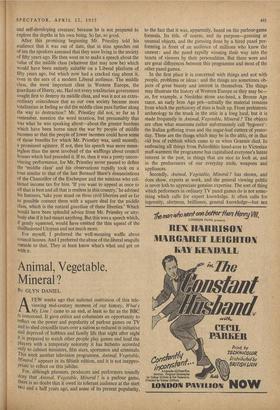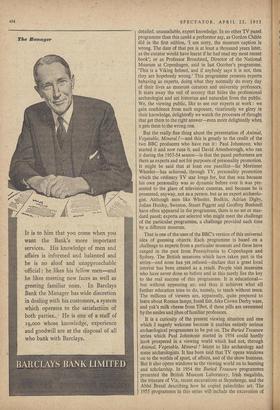Animal, Vegetable,
to the fact that it was, apparently, based on the parlour-game formula. Its title, of course, and its purpose—guessing at unusual objects, and the guessing done by a hired panel per- forming in front of an audience of millions who knew the answer: and the panel rapidly winning their way into the hearts of viewers by their personalities. But there were and are great differences between this programme and most of the other panel games. In the first place it is concerned with things and not with people, problems or ideas: and the things are sometimes ob- jects of great beauty and interest in themselves. The things may illustrate the history of Western Europe or they may be— as, for example, a Neolithic Stone axe-head, a Bronze Age razor, an early Iron Age pot—actually the material remains from which the prehistory of man is built up. From prehistoric archmology to the trunk in the attic is a long haul, but it is made frequently in Animal, Vegetable, Mineral ? The objects are often what museums rather unfortunately call 'bygones' : the Italian goffering irons and the sugar-loaf cutters of yester- day. These are the things which may be in the attic, or in that old box of rubbish which came to us when Grannie died. In embracing all things from Pakeolithic hand-axes to Victorian muff-warmers the programme has capitalised everyone's latent interest in the past, in things that are nice to look at, and in the predecessors of our everyday tools, weapons and appliances. detailed, unassailable, expert knowledge. In no other TV panel programme than this could a performer say, as Gordon Childe did in the first edition, 'I am sorry, the museum caption is wrong. The date of that pot is at least a thousand years later, as the curator would have learnt if he had read my most recent book'; or as Professor Brondsted, Director of the National Museum at Copenhagen, said in last October's programme, `This is a Viking helmet, and if anybody says it is not, then they arc hopelessly wrong.' This programme presents experts behaving as experts, doing what they normally do every day of their lives as museum curators and university professors. It tears away the veil of secrecy that hides the professional archaeologist and art historian and naturalist from the public. We, the viewing public, like to see our experts at work : we gain confidence from such exposure, vicariously we glory in their knowledge, delightedly we watch the processes of thought that get them to the right answer—even more delightedly when it gets them to the wrong one.
But the really fine thing about the presentation of Animal, Vegetable, Mineral ?—and this is greatly to the credit of the two BBC producers who have run it : Paul Johnstone, who started it and now runs it, and David Attenborough, who ran it during the 1953-54 season—is that the panel performers are there as experts and not for purposes of personality promotion. It might be said that at least one panellist—Sir Mortimer Wheeler—has achieved, through TV, personality promotion which the ordinary TV star longs for, but that was because his own personality was so dynamic before ever it was pre- sented to the glare of television cameras, and because he is presented, anyway, not as a person, but as an expert archwolo- gist. Although men like Wheeler. Bodkin, Adrian Digby, Julian Huxley, Swinton, Stuart Piggott and Geoffrey Bushnell have often appeared in the programme, there is no set or stan- dard panel; experts are selected who might meet the challenge of the particular programme, a challenge provided each time by a different museum.
That is one of the uses of the BBC's version of this universal idea of guessing objects. Each programme is based on a challenge to experts from a particular museum and these have ranged in the past from Pennsylvania to Copenhagen and Sydney. The British museums which have taken part in the series—and none has yet refused—declare that a great local interest has been created as a result. People visit museums who have never done so before and in this surely lies the key to the real success of this programme. It is educational— but without appearing so; and thus it achieves what all further education tries to do, namely, to teach without tears. The millions of viewers are, apparently, quite prepared to learn about Roman lamps, fossil fish, fake Crown Derby ware, and yak's milk cheese from Tibet, if these pills are sweetened by the smiles and jibes of familiar professors.
It is a curiosity of the present viewing situation and one which I eagerly welcome because it enables entirely serious archaeological programmes to be put on. The Buried Treasure series which Paul Johnstone started in 1954 could hardly have prospered in a viewing world which had not, through Animal, Vegetable, Mineral ? learnt to like archaeology and some archaeologists. It has been said that TV opens windows on to the worlds of sport, of affairs, and of the show business. But it also opens windows to the viewing world on to learning and scholarship. In 1954 the Buried Treasure programmes presented the British Museum Laboratory, Irish megaliths, the treasure of Vix, recent excavations at Stonehenge, and the Abbe Breuil describing how he copied palxolithic art. The 1955 programmes in this series will include the excavation of the West Kennet Long Barrow, the art and life of the Etruscans, the Piltdown hoax, and prehistoric flint mines. More ambitious places for the succeeding years include Mycenx, Knossos, Jericho, and the Indus cities. In this way the civilisations and cultures of the remote past are brought into the living room.
But what about the reactions of the individual performers to Animal, Vegetable, Mineral ? We have had at least forty-five Performers and I myself have missed only three of the fifty Programmes. At first it was intriguing to meet people who said, 'Didn't I see you on the tele last night?' but now it is a Crashing bore to be unable to travel by train or stay at a hotel without recognition. But this notoriety, inseparable from regular TV appearances, has two compensations. I have learnt an enormous amount from the chair of Animal, Vege- table, Mhzeral ? and from the compulsoiy homework which it involves. And it all does achieve, which is most eminently Worth while, a widespread interest in archaeology and natural history and art. It was said in jest a few months ago that the thousands who crowded to see the Temple of Mithras were impelled to it by Animal, Vegetable, Mineral? This is an exaggeration : the popular interest in archteology has been with us since Layard, the Flood tablets and Schliemann. But TV. is widening that interest to its vast viewing public. if. when several competing TV programmes are available, Animal, Vegetable, Mineral? can stay the hurried knob, twisting that searches for pure entertainment on the screen. it will have been worth while. I write 'have been,' but who knows that in five years' time our familiar experts will not still be examining on our screens Eskimo harpoons and Victorian medicine spoons! Good luck to them! May the five hundredth programme still have Sir Mortimer digging and Professor Bodkin twinkling.












































 Previous page
Previous page